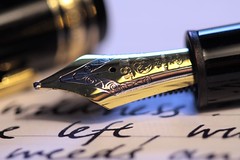 (Image taken from Flickr - by Linda Cronin)
(Image taken from Flickr - by Linda Cronin)Referencing styles are not very easy to use, probably because we are not used to writing many academic papers. Though both of the websites suggested in E-tivity 6 were clear, I still feel unsure about how to properly write a reference. In my opinion, a good university student should have no doubts about how to quote other people’s works at the end of their five-year course, but I think that the majority of Italian students still face problems in dealing with citations.
Exploring APA and MLA websites, I learned that all ‘important’ words (verbs, nouns, pronouns, adjectives and adverbs) must be capitalised when quoting (this was a question I have been asking myself for a long time). Moreover, I found out that in the format by APA if you quote longer works you should either use italics or underline the title, but if you want to cite a shorter work, you are supposed to use quotation marks. Honestly speaking, I find this difference quite silly. Yet, if this is the general rule, I will do my best to follow it! Personally, I prefer using italics rather than underlining, but surprise surprise... according to MLA style the contrary would be much better. I agree with Modern Language Association when it suggests people use “Work Cited” or “Annotated Works Cited” instead of the more generic “Bibliography”. I finally learned that indentation of a long quotation must be five spaces from the left margin and the double-spacing should be maintained. Needless to say, APA and MLA are quite different: here below I would like to mention just a couple of examples. MLA thinks that one should not abbreviate the name of the authors, while according to APA it is preferable to write the authors’ surnames first and then their names’ initials. Also the right place for the year of publication of a work is different: while according to MLA it must be written at the very end, in the APA style it should be inserted after the author’s name. Last but not least, the use of ‘&’ before the last author’s name is suggested by the Modern Language Association, but the American Psychological Association believes that in such a case an ‘and’ would be definitely more appropriate.
In my B.A. thesis I followed my supervisor’s advice and used the single-spacing for long quotation and, as far as indentation was concerned, I did it according to my own taste. I did not used ampersands because I feel that they are more used in commercial contexts, rather than in academic ones. All things considered, the style I used was a mix of APA and MLA styles.
In conclusion, I believe that we should practice a lot not just before our final dissertation, but also on other occasions. Writing academic pieces of work is not an easy task at all and, beside being careful, you also have to carve our plenty of time in order to come up with a clear and precise work. I hope to learn how to quote correctly as soon as possible.
Exploring APA and MLA websites, I learned that all ‘important’ words (verbs, nouns, pronouns, adjectives and adverbs) must be capitalised when quoting (this was a question I have been asking myself for a long time). Moreover, I found out that in the format by APA if you quote longer works you should either use italics or underline the title, but if you want to cite a shorter work, you are supposed to use quotation marks. Honestly speaking, I find this difference quite silly. Yet, if this is the general rule, I will do my best to follow it! Personally, I prefer using italics rather than underlining, but surprise surprise... according to MLA style the contrary would be much better. I agree with Modern Language Association when it suggests people use “Work Cited” or “Annotated Works Cited” instead of the more generic “Bibliography”. I finally learned that indentation of a long quotation must be five spaces from the left margin and the double-spacing should be maintained. Needless to say, APA and MLA are quite different: here below I would like to mention just a couple of examples. MLA thinks that one should not abbreviate the name of the authors, while according to APA it is preferable to write the authors’ surnames first and then their names’ initials. Also the right place for the year of publication of a work is different: while according to MLA it must be written at the very end, in the APA style it should be inserted after the author’s name. Last but not least, the use of ‘&’ before the last author’s name is suggested by the Modern Language Association, but the American Psychological Association believes that in such a case an ‘and’ would be definitely more appropriate.
In my B.A. thesis I followed my supervisor’s advice and used the single-spacing for long quotation and, as far as indentation was concerned, I did it according to my own taste. I did not used ampersands because I feel that they are more used in commercial contexts, rather than in academic ones. All things considered, the style I used was a mix of APA and MLA styles.
In conclusion, I believe that we should practice a lot not just before our final dissertation, but also on other occasions. Writing academic pieces of work is not an easy task at all and, beside being careful, you also have to carve our plenty of time in order to come up with a clear and precise work. I hope to learn how to quote correctly as soon as possible.




Hi Francesca,
RispondiEliminaI've just read your post concerning the APA and MLA styles. Like you said, I too still feel quite confused about how to properly write a reference. Both guidelines provide a lot of rules to follow with subtle differences so that it is very difficult to have a clear idea of what it is required. I remember that when I worked on my third-year dissertation I had difficulties in writing references and the bibliography. I found them very boring! Yet, I believe that it is just a matter of learning the system; then, all becomes automatical. Practice is always the best way to learn, so I think it is a good thing to start learning how to correctly quote.
As regards our linguistic feedback, I noticed just few things:
- I would write: "you should EITHER use italics or underline the title". If you put "either" after the verb "use" it implies that the verb "use" refers also to the second part of the sentence and that's not the case;
-As regards punctuation: I would replace the comma with a full stop after "I find this difference quite silly." Then, I would add a comma after "Yet,".
I think that's all. I found your post well written and well organized.
See you soon, have a nice day!
Francesca